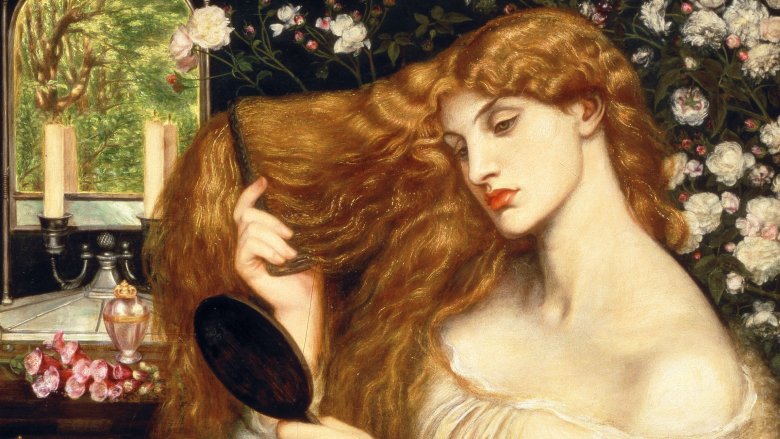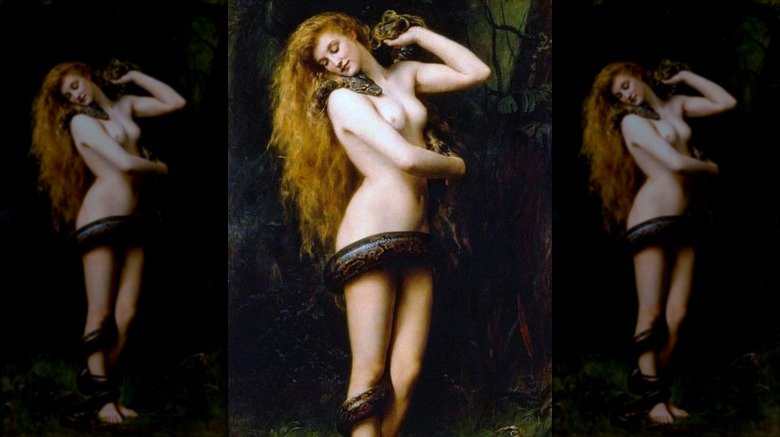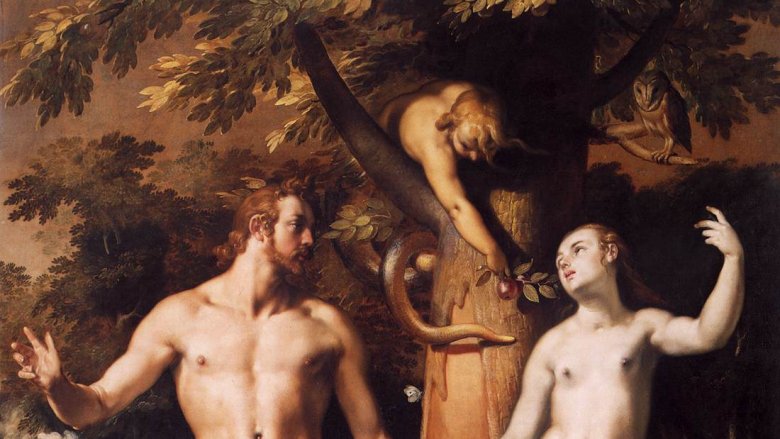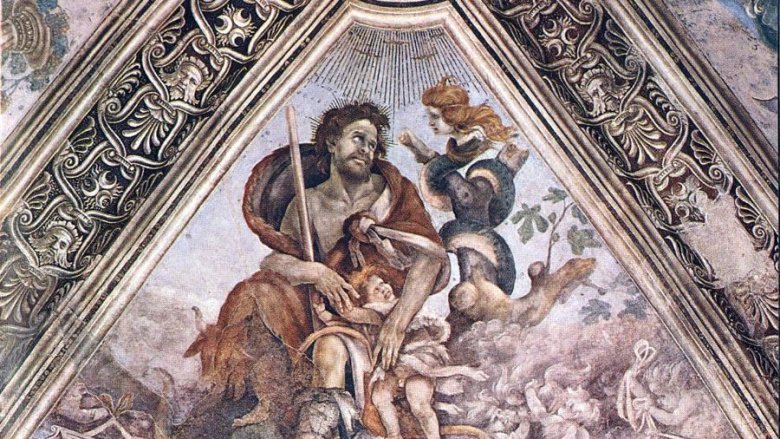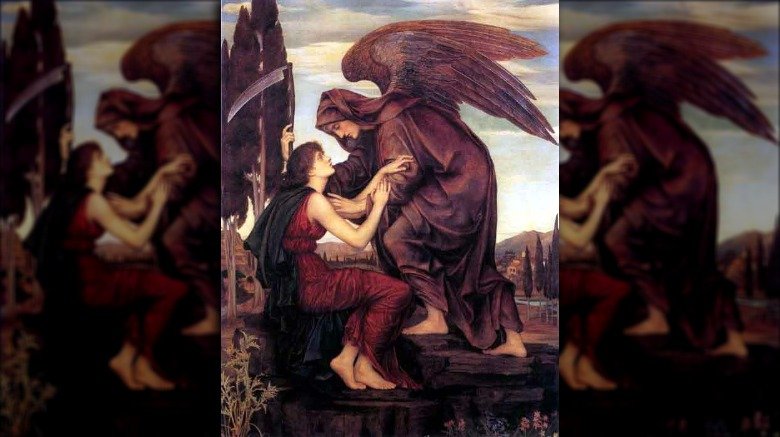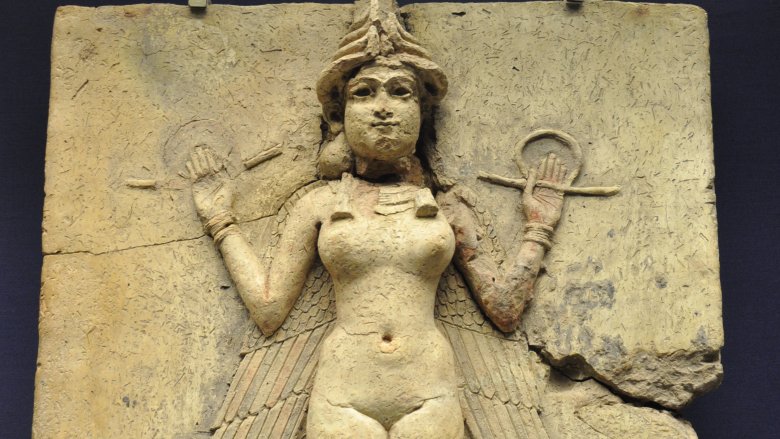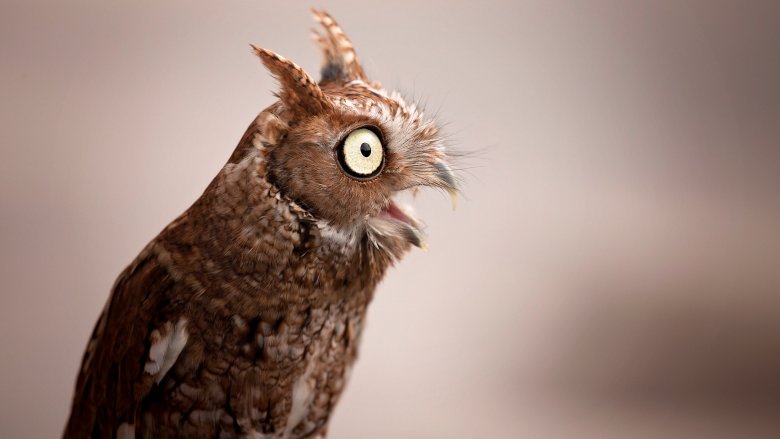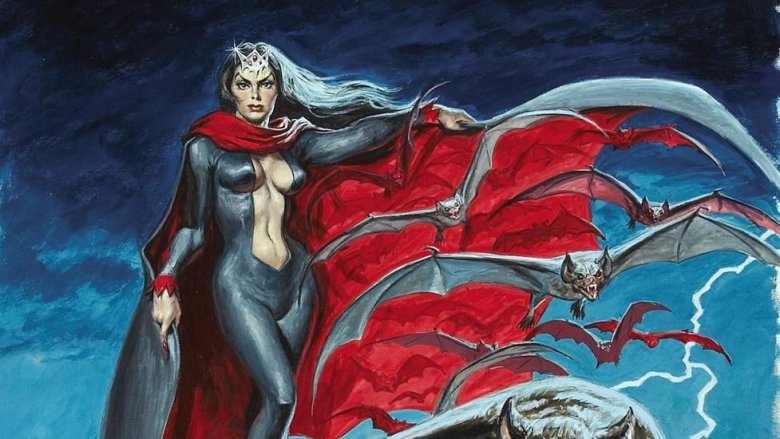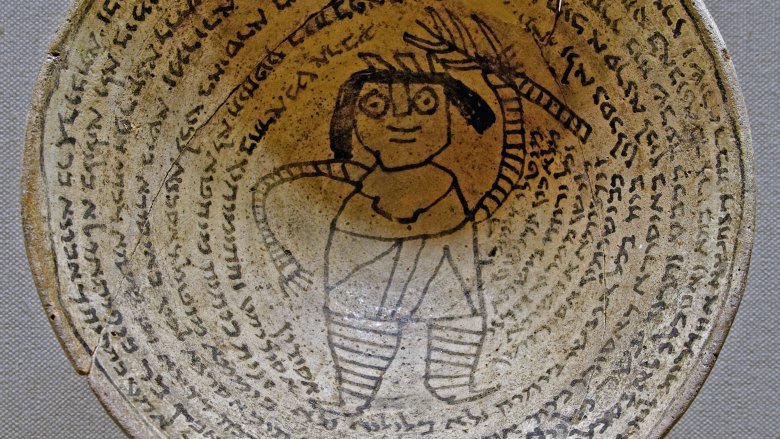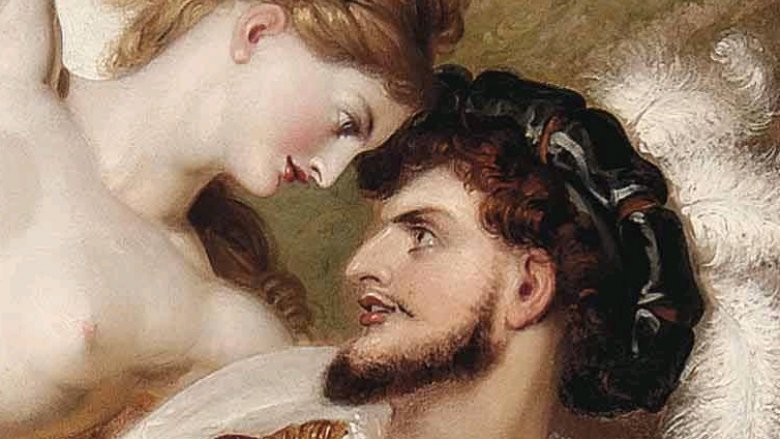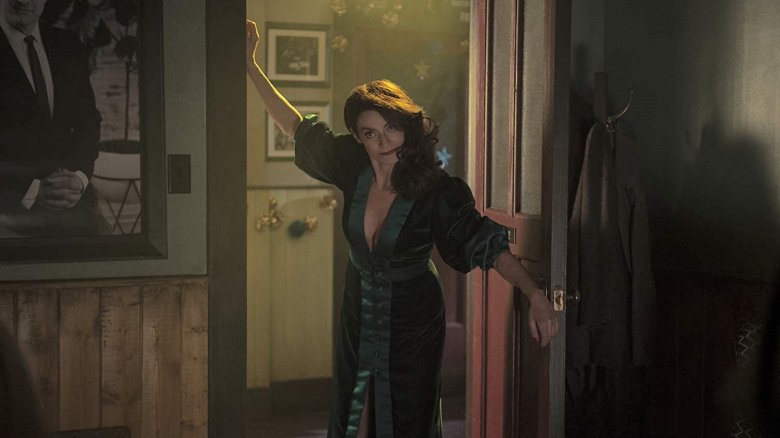The Untold Truth Of Lilith
If you're the type of person to enjoy spooky media, whether that's movies, TV, books, comics, or video games, there's a chance you might have encountered the figure of Lilith. Depending on the source, you might know her as Adam's real first wife who preceded Eve, or maybe as the first vampire, or a succubus who gives men sexy dreams. In The Chilling Adventures of Sabrina, she's Satan's Concubine disguised as a vampy high school teacher. If you're Jewish, you might think of her as a demoness who eats babies. To others, she might be a symbol of oppressed womanhood, or even a goddess.
But what you might not know is where she came from. It might be easy to assume she comes from the Bible, as she is known to be Adam's first wife, and Adam is definitely from the Bible. If that's the case, it might surprise you to learn that the word "Lilith" only appears once in the Bible, and it has nothing whatsoever to do with Adam or Eve. Lilith is, in fact, probably not Jewish at all, and has a complicated origin that involves a lot of time, a lot of sources, and a lot of interpretations. If you're the kind of person to be easily tempted by a line like that, here are some things you might not know about Lilith, the alluring mother of demons.
Lilith was a continuity patch
If you read the first few chapters of the book of Genesis in the Bible, you'll notice that there are two accounts of the creation of human beings that are slightly different. The first, in Genesis 1:27, says God created man and woman at the same time, both in his own image. Chapter 2, however, gives the more familiar expanded version where God makes Adam out of the clay and then makes Eve from his rib. According to many Biblical scholars who subscribe to a form of critical analysis known as the documentary hypothesis, the reason for this is that these two versions represent two different traditions — one from a group who envisioned a cosmic, impersonal God, and one from a group who thought of God as more personal and human — that were stitched together by an editor at a later date. To those who follow the more traditional belief that Moses wrote the book of Genesis, the second version of the story is simply an expansion of the first.
In the tradition of rabbinic Judaism, however, the belief became increasingly common that the two stories were not repetitions of each other, but rather that they were two separate events featuring two different women: the first, a woman made from clay just as man was named Lilith, and the second, a woman made from man's rib named Eve. The early rabbinical commentary called the Genesis Rabbah features references to Adam having a wife before Eve, but it would take a few more centuries for the Lilith legend as we know it to take shape.
Lilith just wanted to be on top
The earliest version of what a modern reader would recognize as the Lilith legend comes from the collection of satirical proverbs known as The Alphabet of Ben Sirah, written sometime between the 8th and 11th centuries A.D. The story combines various elements from folk tradition and superstition into a cohesive whole that manages to make belief in the story of Lilith feel more Biblical and less, well, superstitious.
According to Ben Sirah, when God said that it's not good for man to be alone, he made a woman named Lilith out of the dust, just as he had done Adam, making her his equal. This, for medieval Jews, is where the problem started, because she refused to be subservient to Adam, especially in the bedroom department. (Okay, yes, they lived outdoors, but you get it.) Lilith specifically tells Adam that she wants to lie on top when they get all fruitful and multiplicative. Adam says no, because he's the superior one so he should always both literally and figuratively be on top. Lilith naturally counters that they are equals because they were both made from the earth in God's image. Adam refuses to compromise, and so Lilith shouts the unspeakable true name of God — a curse that often has literally explosive effect in popular legend — and flies away. Yes, flies. This is, admittedly, a pretty dramatic way for what is literally the first relationship on Earth to break up, but it's still less traumatic than, for example, Midsommar.
Don't leave your babies around Lilith
Legend says that when Adam told God that the woman he had made for him flew away, God sent three angels — Senoy, Sansenoy, and Semangelof — to retrieve her. They found her in the middle of the Red Sea, surrounded by demons, where she was employed in her new role, namely giving birth to a hundred-plus monsters a day, known as lilim. The angels deliver God's message to her: She can return to Adam, no harm no foul, or God will kill 100 of her children every day. Lilith refuses and continues to live in the wild as a demoness, a mother of monsters, and an assailant of children. Male children were thought to be vulnerable to Lilith's assaults up until they were eight days old, at which point they would be circumcised and therefore dedicated to God. Female children were considered at Lilith's mercy for 20 days. The demoness could be held at bay, however, by magical amulets inscribed with the names of the three angels sent to capture her. If she was warded off from a human child by an amulet, she would be forced to expend her bloodlust on one of her own children. (Perhaps needless to say, when God tried his hand again at creating a woman, he made her from Adam's rib in order to make clearer who was the boss of whom. This has definitely gone well for humans as a society.)
In this way, the Ben Sirah story manages to reconcile existing traditions of Lilith as a baby-killing demon, a seducer of Adam, and Adam's first wife.
Or Lilith is the queen of demons
While the story of Lilith as the failed first draft of womanhood is the most commonly known one today, there is a whole separate tradition in which Lilith is simply a demoness, whole hog. In fact, she's generally regarded as the queen of the demons in many demonologies, frequently married to one of the most powerful demons, usually either Samael or Asmodeus. In some versions there are two or three Liliths — usually a Greater and a Lesser Lilith — one married to Asmodeus and one married to Samael. One story tells of the two demon lords fighting over the younger Lilith, who is described as being a beautiful maiden as far as her waist and then just fire from the waist down. (Literal fire, not metaphorical fire.)
In this role she is still considered a murderer of children — various stories attribute to her the deaths of Job's sons and some of Solomon's children, for example — but she also looms large as a succubus figure, a seducer of men. She seduces men at night and causes ... you know, dreams ... from which she becomes pregnant, only to murder these children. She has dominion over children conceived by candlelight, on days on which it is forbidden to have intercourse, or when the woman is all the way naked, and she can kill these children at any time she wants. If any of these are true, some of y'all might need to check on your kids real quick. If you hear your baby laughing for no reason, it might be because Lilith is tickling them.
Lilith might not be Jewish originally
The origins of Lilith stretch back long before the medieval traditions that define how we think of her today and even before much of the Hebrew Bible was written. The figure of Lilith seems to have been informed by various Mesopotamian monsters that can be found as far back as the seventh century B.C. One possible reference to a Lilith-like monster can be found in the Sumerian Epic of Gilgamesh, in which she is a spirit haunting a tree growing in the garden of the goddess Inanna. Amulets found in Arslan Tash in northwest Syria dating from the seventh century B.C. seem to be invoking protective magic against Lilith as well.
Perhaps the biggest influence on the Jewish mythology, however, would be the Assyrian demons Lilu, Lilit, and Ardat Lilit, the second of which is the specific name most influencing Jewish ideas of Lilith. The word Lilit seems to be the feminine version of Lilu, an Akkadian word which is related to the word "Alu," or demon. Such demons, both male and female, appear in Assyrian, Sumerian, and Babylonian literature. Some scholars believe the word is related to the Hebrew word "layil," meaning "night" — hence Lilith's reputation as a goddess or demon of the night — while others argue that it comes from the Sumerian word "lil," meaning "wind" or "air," making the original Lilit a demoness of the storm. Prior to the legends assembled by such works as the Ben Sirah, Lilith would likely have been seen primarily as a winged demon who prowls desolate and wild areas.
Biblical Lilith is a real hoot
Despite the current understanding of Lilith as a character closely tied to the famous Biblical figures of Adam and Eve, the fact is the word "Lilith" appears exactly one time in the canonical Bible, and it has nothing whatsoever to do with the Garden of Eden or a desire of one person or another to be on top. The single reference to Lilith appears in Isaiah 34:14, in a passage describing the destruction that will be found after God lays his judgment on the nation of Edom. It says that thorns and brambles will grow over the city, and its walls will become a home for jackals and owls. It goes on to say that the city will be filled with hyenas and satyrs, and "there too shall Lilith repose."
This verse is translated in a variety of ways, by people who are varying degrees of willing to include mythological monsters in their Bible translation. The Greek translation of the Hebrew Bible known as the Septuagint translates Lilith as onokentauros, which is like a centaur whose horse parts are donkey parts, which to be honest is not very similar to Lilith. Numerous English versions, including the King James Version, translate it as "screech owl," while more modern translations like the New International Version give the much more vague "night creatures." A special shout-out, however, should be reserved for the 1922 Moffatt Translation and the 1950 Knox Bible, which both just straight up translate it as "vampires." So, you know, maybe owls, maybe vampires, maybe a man with donkey legs.
Lilith, queen of the vampires
The fifth-century Latin translation of the Bible uses a word to translate the word "Lilith" in Isaiah that is preserved in certain English versions as well, including the Wycliffe Bible of 1395 and the Douay-Rheims Bible of the 16th century: lamia. While this word might be unfamiliar to most people, it should make absolute sense to those familiar with Greco-Roman mythology and folklore. To the Greeks and Romans, Lamia was the name of a queen who turned into a child-eating monster after Hera killed her children, though in more popular understanding the word "lamia" was a generic term for all kinds of child-frightening bogeywomen and/or seductresses who were half-snake, drank blood, and gave birth to monsters.
The figure of Lilith obviously bears a striking resemblance to the lamia, and that includes the trait of drinking blood. Though the concept of vampires as we think of them is a relatively modern — and European — idea that has evolved over the years thanks to folklore, literature, movies, and other pop culture, nevertheless the blood-drinking winged first wife of Adam has perhaps inevitably come to be associated with vampires. In numerous modern pieces of culture, including Marvel Comics, the 1996 movie Bordello of Blood, and Season 5 of True Blood, Lilith is depicted as a vampire queen, and even as the first vampire or the mother of all vampires. Being the baby-eating queen of Hell who births a hundred demons every day isn't cool enough for some people, apparently.
How to protect your child from Lilith
Long before the final version of the Lilith story congealed in the Alphabet of Ben Sirah, Lilith could be found in magical inscriptions on bowls and amulets meant to drive away the demoness from as early as the sixth century A.D. These talismans invoke the names of the angels Senoy, Sansenoy, and Semangelof, or sometimes the prophet Elijah, in order to protect young children from the grasp of Lilith. These amulets are mentioned in the Ben Sirah, and in fact, the story probably exists to give a more religious justification for the otherwise pretty superstition-and-magic-heavy amulets. The three angels are also found depicted on walls of children's rooms, charms, and other talismans, in which they are portrayed as somewhat fearsome beasts themselves, with rooster's heads and snakes in place of legs. Others depict Lilith as bound in chains and helpless surrounded by the names of various Jewish patriarchs and luminaries. Some of the invocations found in bowls that were inscribed with the purpose of driving Lilith out of the house were written in the form of divorce papers, which is, you know, a choice.
The need to protect children from Lilith was so prevalent an idea that some people argue that the word "lullaby" actually derives from the words written on the amulets hung on the walls of infants: "Lilith, abi!" which means "Lilith, begone!" (This is almost certainly not true — "lullaby" is probably related to the word "lull" and ultimately onomatopoetic in origin — but it's pretty fun to think about.)
In case the other versions of Lilith weren't weird enough
The esoteric school of Jewish mysticism known as Kabbalah presents several alternate takes on Lilith that can sometimes stray pretty significantly from the more mainstream understanding of her as either Adam's first wife or even just a demon. A Kabbalistic demonology known as the Treatise on the Left Emanation says that Lilith was not created with Adam, but rather that Samael and Lilith were created at the same time as Adam and Eve to be their dark mirror. Both couples were created as double-faced, androgynous beings containing aspects of both male and female, with the implication being that they were the earthly reproduction of an androgynous God. Another passage from this treatise names Lilith as the serpent who tempted Eve in the garden, a figure who is generally associated with Satan in modern understanding.
One of the most important works in Kabbalah is a group of books known as the Zohar, which contain commentary on the mystical aspects of the Torah, and of course the Zohar has some ideas about Lilith. According to this version, when God created Adam, his body was without a soul, and a thousand evil spirits tried to attach themselves to him. God drove the demons off with a cloud and he gave Adam a soul, at which point a female formed, joined at his side. Adam and his conjoined, literal soulmate came to life and God sawed them in two. This woman was Lilith and she immediately flew out to the sea to have demon babies.
Lilth goes mainstream
Despite being a figure that does not appear at all in the canonical Bible and that only arises from folklore, tradition, and foreign mythology, Lilith has enjoyed great success as a character in various forms of popular culture. She is, for example, a major player in The Chilling Adventures of Sabrina, where she is arguably the main antagonist, the mother of demons, and Satan's very jealous concubine. The archetype of the "evil wife" that Lilith represents informed the choice of naming Frasier Crane's cold, somewhat shrewish wife (and later ex-wife) Lilith Sternin. On the flipside of that portrayal, a more modern reappraisal of Lilith's character would reveal her as a woman who was punished for demanding equality, and as such, she became something of a feminist icon, giving her name to the popular 1990s all-woman touring music festival Lilith Fair.
The seminal anime series Neon Genesis Evangelion borrows a lot of trappings from Christianity and Jewish mysticism, and Lilith is no exception. Lilith is revealed to be the name of the second angel (not really angels? They're actually like weird aliens, maybe?) and the progenitor of the Lilin, who are actually ... well, no spoilers. Lilith likewise can be found sprinkled all across pop culture, from books to movies to anime to video games such as Castlevania, Final Fantasy, and Darkstalkers. Sometimes she's depicted as a vampire, sometimes a demon, sometimes a succubus, and sometimes just a domineering wife. Not a bad fate for a Mesopotamian night monster who just wanted to be on top.
